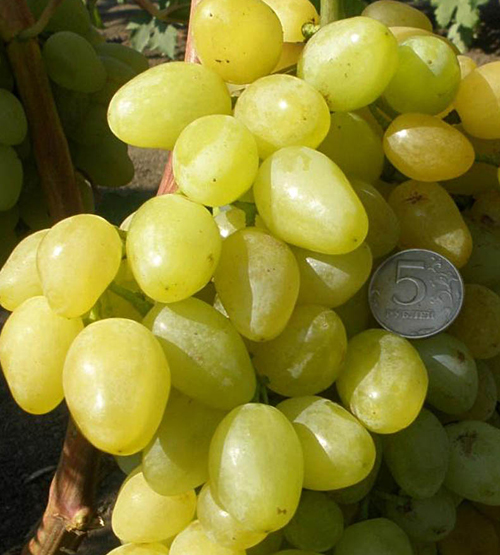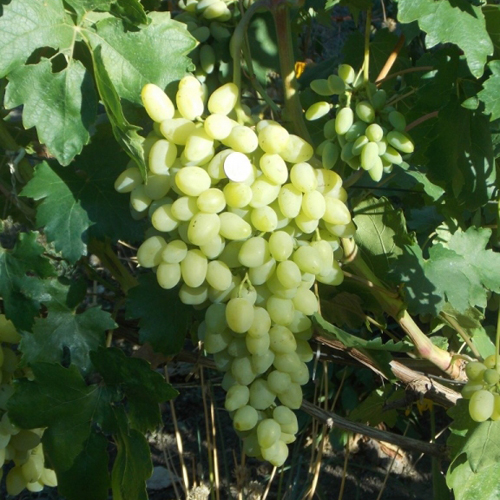Grape variety Zarnitsa
Zarnitsa is a magnificent in appearance, light-colored hybrid of table grapes, created by the famous domestic amateur breeder Viktor Krainov at the beginning of the 2000s. The author used his favorite pair of varieties as parental forms - Mascot, originally from the Novocherkassk Scientific Research Institute of Viticulture and Winemaking, and Radiant kishmish, born by the works of Moldovan scientists. From a similar crossing, Viktor Nikolaevich gave birth to more than a dozen brainchildren, which won the recognition and sincere love of many amateur winegrowers and farmers.

So Zarnitsa, over the years since its inception, has gained a lot of admirers who, in addition to stunning aesthetic qualities, appreciate the variety for the early ripening of grapes, high and stable yield, comparative unpretentiousness in cultivation and excellent taste of berries. The bunches of our heroine are very reminiscent of the fruits of the famous Ukrainian variety Arcadia, in connection with which Zarnitsa firmly entrenched the name-synonym - Early Arcadia, tk. it ripens 5 - 7 days earlier.
Agrobiological properties
The bushes are distinguished by a very high vigor of growth, especially in a self-rooted culture. Each plant can easily occupy 5 - 6 meters of the length of the trellis, showing the corresponding yield. Leaves are formed large, rounded, consisting, as a rule, of five lobes, between which there is an average degree of dissection. The profile of the leaf blade is flat, but the edges of the blades are often raised upward. The leaf surface is smooth, dark green with veins of lighter tones, at the base of which pink tints can sometimes appear. The upper side cuts are of medium or shallow depth, their shape can be very diverse - lyre-shaped, slit-like with parallel sides, or have the form of a recessed angle. The lower notches are mostly barely marked or absent. Petiole notches are found closed with narrow elliptical openings, open in the form of a lyre with a pointed bottom, and also lancet. The petioles are rather long, greenish at first, but gradually reddening due to the accumulation of anthocyanin pigmentation. The denticles along the perimeter of the lamina are above average in size, have wide bases, straight lateral sides and sharp tops. The flowers are bisexual, which allows plants to perfectly pollinate with their own pollen, forming perfectly executed brushes without signs of pea berries, shedding of buds or ovaries. One of the disadvantages of Zarnitsa is the slow ripening of the wildly growing shoots, but the winegrower is quite capable of correcting it with the help of timely minting of the vine. The matured annual growth becomes reddish-brown in color.

The bunches are the main decoration of this variety. By the time the berries ripen, they reach very large sizes - up to 30 cm long, and weighing up to one and a half kilograms. Their shape is elongated or broadly conical, the density is moderate. Due to the not too tight fit of the grapes to each other, they do not deform in the brush, and do not wrinkle. The excellent evenness of the fruit gives the bunches a particularly elegant appearance. Combs of Zarnitsa are herbaceous, rather long, green, but with a long stay of grapes on the bushes and good lighting of the fruit zone, reddish tones appear in color. The berries are large, nipple-shaped, with an average weight of 8 - 10 grams. The largest grapes can weigh up to 15 g. Outside, they are painted in a very appetizing bright yellow color and are covered with a light bloom of a protective spring of medium intensity. The flesh of the fruit is quite dense, crispy when bitten, has a very pleasant balanced taste with a neutral aroma and aftertaste. Freshly squeezed colorless juice, sugar content 16 - 18 g / 100 cm3, and titratable acidity 6 - 7 g dm3... According to the testimony of a number of owners, with a late harvest in September, the level of sugar accumulation can reach 23%. The skin of the grapes is very thin, almost intangible when eaten. The seeds are small, 1 - 2 in number in the berry, also do not cause discomfort when tasting. Gastronomic estimates of Zarnitsa grapes are admittedly high.
Due to these properties and characteristics, the harvested crop is used mainly for fresh consumption. Excellent presentation allows Zarnitsa to be considered a "market" variety that enjoys great attention of buyers and does not remain stale on the shelves. Cultivation for commercial purposes is also favored by the early ripening of the bunches, in connection with which the harvest enters the market during a period of high grape prices, providing the owner with a greater income per unit area. Also, an important factor is the excellent transportability of the fruits, which allows them to be moved over long distances without the risk of damage on the road or deterioration in appearance. But the removed brushes of our heroine are not intended for long-term storage, and they avoid damage for several weeks only if refrigerators are used. Owners cultivating the "sun berry" for personal consumption successfully use the surplus harvest for harvesting for the winter, making wonderful jams, jams, compotes and marinades from sweet grapes. The dense berry keeps its shape well during canning with whole fruits, imparting all the richness of its taste to the finished product.
The duration of the growing season, from the moment the buds open in the spring, until the bunches are ready for harvest, is only 110 - 115 days, characterizing the hybrid form as very early. In the conditions of the Lower Don region, where it comes from, removable ripeness usually occurs at the beginning of the first decade of August, with the sum of active temperatures equal to 2250 - 2350 ° C. Such modest requirements for heat supply make it possible for Zarnitsa to grow successfully and fully bear fruit not only in the south, but also in many regions of the middle zone of our country. In particular, in the Central Black Earth Zone, which by no means can be called traditional for viticulture, our heroine is almost guaranteed to mature. Here, however, one should take into account its average frost resistance, not exceeding −21 ... −23 ° С, covering the aboveground part of the plants for the winter.
The productivity of the bushes can reach high values, especially in those of them that have impressive dimensions and a large supply of perennial wood. Excellent performance is directly influenced by both the large size and mass of the brushes, and their significant number on fruitful shoots. In order to prevent overloading of plants, it is necessary to carefully regulate their yield, taking into account age, vitality and growing conditions. So, the spring pruning of bushes that have entered full fruiting is usually carried out for 30 - 35 eyes, with the length of the fruit arrows of the order of 6 - 8 buds. After the start of the growth of shoots, a fragment of those of them that are poorly developed or are sterile is produced. Ultimately, there should be 22 - 24 productive vines, on which inflorescences are thinned out before flowering, leaving one, the largest on each shoot. Ultimately, with this approach, the harvest will be at least 20 kg of grapes from each plant, and our heroine is able to carry this volume without signs of excessive stress.
During the growing season, several preventive spraying with fungicides against common fungal diseases will be required. Wasps are weakly damaged. Fruit cracking also practically does not occur.The bunches can hang on the bushes for a long time after ripening, the only danger for them is the intense heat, due to which the grapes can be fed.
Reproduction of the Zarnitsa variety is easy. It demonstrates both good rooting of its own cuttings and excellent adhesion to traditional rootstocks.








